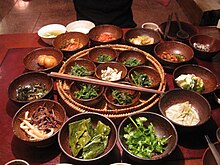Korean temple cuisine
| Korean temple cuisine | |

Korean temple cuisine at Sanchon, a restaurant located in Insadong, Seoul.
|
|
| Korean name | |
|---|---|
| Hangul | 사찰 |
| Hanja | |
| Revised Romanization | sachal eumsik |
| McCune–Reischauer | sach'al ŭmsik |
Korean temple cuisine refers to a type of cuisine that originated in Buddhist temples of Korea. Since Buddhism was introduced into Korea, Buddhist traditions have strongly influenced Korean cuisine as well. During the Silla period (57 BC – 935 AD), chalbap (찰밥, a bowl of cooked glutinous rice) yakgwa (약과, a fried dessert) and yumilgwa (a fried and puffed rice snack) were served for Buddhist altars and have been developed into types of hangwa, Korean traditional confectionery. During the Goryeo Dynasty, sangchu ssam (wraps made with lettuce), yaksik, and yakgwa were developed, so spread to China and other countries. Since the Joseon Dynasty, Buddhist cuisine has been established in Korea according to regions and temples.
On the other hand, royal court cuisine is closely related to Korean temple cuisine. In the past, when the royal court maids called sanggung, who were assigned to Suragan (hangul: 수라간; hanja: ; the name of the royal kitchen), where they prepared the king's meals, became old, they had to leave the royal palace. Therefore, many of them entered Buddhist temples to become nuns. As the result, culinary techniques and recipes of the royal cuisine were integrated into Buddhist cuisine.
Baek kimchi (white kimchi) to which pine nuts have been added, bossam kimchi (보쌈김치), and gosu kimchi (고수김치, coriander kimchi) are famous in Buddhist temples of Gyeonggi and Chungcheong Province. In Jeolla Province, godeulppagi kimchi (고들빼기김치, kimchi made with Youngia sonchifolia), gat kimchi (갓김치, kimchi made with Brassica juncea var. integrifolia), and juksun kimchi (죽순김치, bamboo shoot kimchi), all of which include deulkkaejuk (perilla congee) as an ingredient, are famous. None of these varieties of kimchi contain garlic, scallions, or jeotgal (salted fermented seafood), as foods in the genus Allium are generally avoided by traditional Buddhist monks and nuns of China, Korea, Vietnam and Japan.
...
Wikipedia
